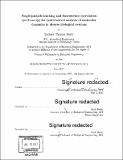| dc.contributor.advisor | Mark Bathe. | en_US |
| dc.contributor.author | Barry, Zachary Thomas | en_US |
| dc.contributor.other | Massachusetts Institute of Technology. Department of Biological Engineering. | en_US |
| dc.date.accessioned | 2017-12-05T19:15:20Z | |
| dc.date.available | 2017-12-05T19:15:20Z | |
| dc.date.copyright | 2017 | en_US |
| dc.date.issued | 2017 | en_US |
| dc.identifier.uri | http://hdl.handle.net/1721.1/112494 | |
| dc.description | Thesis: Ph. D., Massachusetts Institute of Technology, Department of Biological Engineering, 2017. | en_US |
| dc.description | Cataloged from PDF version of thesis. | en_US |
| dc.description | Includes bibliographical references. | en_US |
| dc.description.abstract | Fluorescence microscopy has proven to be immensely powerful for the study of biological systems at both the cellular and systems biological levels. The ability to specifically label a single molecular species fluorescently has enabled the study of complex cellular structures through the visualization of their constituent components both individually as well as in context of the overall structure. Since the advent of engineered fluorescent proteins (such as GFP) and other proteins capable of being genetically encoded as fusion constructs, the utility of fluorescence microscopy has increased exponentially in terms of the ability to efficiently, specifically label desired molecules while limiting perturbations to the biology under study. With this enhanced ability of visualization came a hand-in-hand evolution of computational techniques to extract quantitative information from microscopy images. In this thesis, I focus on the application of fluorescence imaging at the biophysical level in living cells: analyzing the motion/dynamics of single molecules and complexes, which are small relative to the structures of the cell, in order to elucidate their molecular function and mechanism. The motion of these "particles" within living cells is necessarily related to their functions as well as their interacting partners, which can vary dynamically during their lifetimes. Observation and analysis of this motion using a combination of fluorescence microscopy and robust quantitative analysis allows one to infer these characteristics. Here, I study three diverse biological systems in the context of live-cell fluorescence microscopy and biophysical analysis: 1) the transport of 0-actin mRNA particles in primary mouse neurons, 2) kinetochore motion during cell division, specifically focusing on anaphase dynamics, and 3) the motion of cell-growth-implicated membrane proteins in Bacillus subtilis. | en_US |
| dc.description.sponsorship | Funded by the NSF Physics of Living Systems PHY 1305537. | en_US |
| dc.description.statementofresponsibility | by Zachary Thomas Barry. | en_US |
| dc.format.extent | 211 pages | en_US |
| dc.language.iso | eng | en_US |
| dc.publisher | Massachusetts Institute of Technology | en_US |
| dc.rights | MIT theses are protected by copyright. They may be viewed, downloaded, or printed from this source but further reproduction or distribution in any format is prohibited without written permission. | en_US |
| dc.rights.uri | http://dspace.mit.edu/handle/1721.1/7582 | en_US |
| dc.subject | Biological Engineering. | en_US |
| dc.title | Single-particle tracking and fluorescence correlation spectroscopy for systems-level analysis of molecular dynamics in diverse biological systems | en_US |
| dc.type | Thesis | en_US |
| dc.description.degree | Ph. D. | en_US |
| dc.contributor.department | Massachusetts Institute of Technology. Department of Biological Engineering | |
| dc.identifier.oclc | 1011512107 | en_US |
